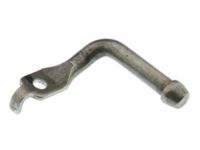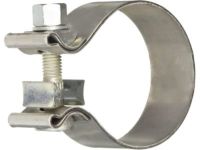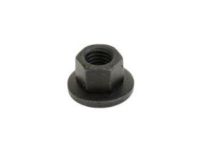Because of a Federally-mandated extended warranty which covers emission-related components such as the catalytic converter, check with a dealer service department before replacing the converter at your own expense. A catalytic converter (or catalyst) is an emission control device in the exhaust system that reduces certain pollutants in the exhaust gas stream. There are two types of converters. An oxidation catalyst reduces hydrocarbons (HC) and carbon monoxide (CO). A reduction catalyst reduces oxides of nitrogen (NOx). A catalyst that can reduce all three pollutants is known as a "Three-Way Catalyst" (TWC). All models covered are equipped with two TWCs, one below each exhaust manifold flange. The upper end of each catalyst has a short inlet pipe with a mounting flange that bolts to the exhaust manifold flange. The lower end of each catalyst is welded to a longer outlet pipe. The left and right catalyst outlet pipes are secured to the rest of the exhaust system by large screw-type clamps. The test equipment for a catalytic converter (a "loaded-mode" dynamometer and a 5-gas analyzer) is expensive. If you suspect that the converter on your vehicle is malfunctioning, take it to a dealer or authorized emission inspection facility for diagnosis and repair. Whenever you raise the vehicle to service underbody components, inspect the converter for leaks, corrosion, dents, and other damage. Carefully inspect the welds or flange bolts and nuts that attach the front and rear ends of the converter to the exhaust system. If you note any damage, replace the converter. Although catalytic converters don't break too often, they can become clogged or even plugged up. The easiest way to check for a restricted converter is to use a vacuum gauge to diagnose the effect of a blocked exhaust on intake vacuum. Connect a vacuum gauge to an intake manifold vacuum source. Warm the engine to operating temperature, place the transaxle in Park (automatic models) or Neutral (manual models), and apply the parking brake. Note the vacuum reading at idle and write it down. Quickly open the throttle to near its wide-open position and then quickly get off the throttle and allow it to close. Note the vacuum reading and write it down. Do this test three more times, recording your measurement after each test. If your fourth reading is more than one in-Hg lower than the reading that you noted at idle, the exhaust system might be restricted (the catalytic converter could be plugged, OR an exhaust pipe or muffler could be restricted). To replace the catalytic converter, raise the vehicle and place it securely on jackstands. Spray a liberal amount of penetrating oil onto the threads of the exhaust pipe-to-exhaust manifold bolts and the clamp bolt nut that connects the catalyst outlet pipe to the rest of the exhaust system. Also spray some penetrant on the two bolts and nuts that secure the small bracket between the two catalyst outlet pipes. Wait awhile for the penetrant to loosen things up. While you're waiting for the penetrant to do its work, disconnect the electrical connector for the downstream oxygen sensor and remove the downstream oxygen sensor. Unscrew the upper exhaust pipe-to-exhaust manifold flange bolt nuts. If they're still difficult to loosen, spray the threads with some more penetrant, wait awhile, and try again. Remove the bolt that secures the catalyst outlet pipe to the small support bracket between the catalyst outlet pipes. If you're removing both catalytic converters, remove both bolts and remove the support bracket. The nuts are tack-welded to the bracket, so don't try to unscrew them; instead, unscrew the bolts from above. Remove the nut from the clamp bolt that secures the slip joint between the catalyst outlet pipe and the rest of the exhaust system. If it's still difficult to loosen, spray the threads with some more penetrant, wait awhile, and try again. If you're removing both catalytic converters, remove the nuts from both clamps. Remove the catalytic converter. Remove and discard the old flange gasket. Installation is the reverse of removal. Be sure to use a new flange gasket and new bolts and nuts at the exhaust manifold mounting flange. The manufacturer also recommends using a new clamp at the slip joint between the catalyst outlet pipe and the exhaust pipe. Coat the threads of the clamp bolt and the exhaust manifold bolts with anti-seize compound to facilitate future removal. Tighten the fasteners securely. Once the catalytic converter is reattached to the exhaust manifold and to the rest of the exhaust system, install the small support bracket. Again, it's a good idea to use new nuts and bolts and to coat the threads of the bolts with anti-seize compound. Tighten the nuts and bolts securely.
Posted by MoparPartsGiant Specialist 












